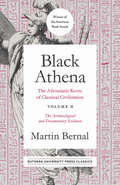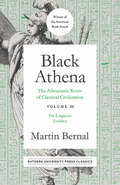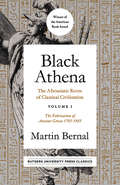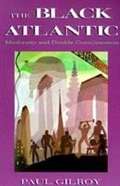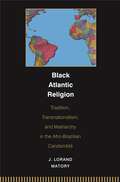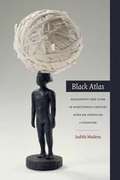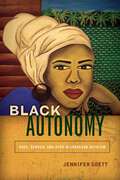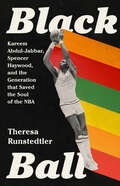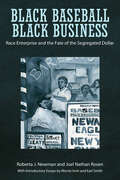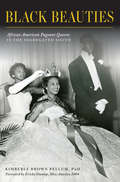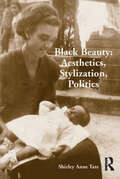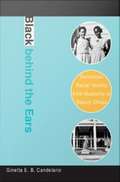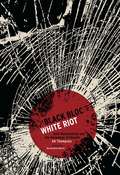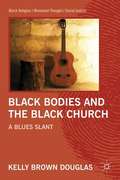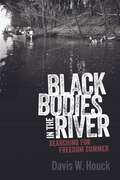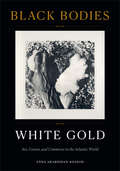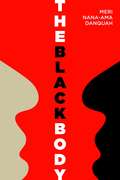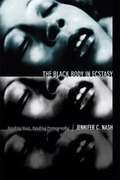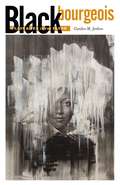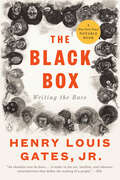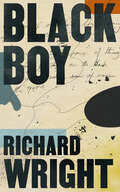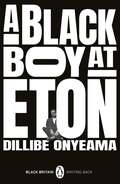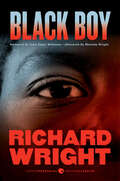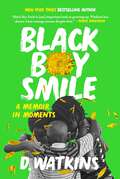- Table View
- List View
Black Athena: The Afroasiatic Roots of Classical Civilization Volume II: The Archaeological and Documentary Evidence
by Martin BernalBlack Athena, an audacious three-volume series, strikes at the heart of today's most heated culture wars. Martin Bernal challenges Eurocentric attitudes by calling into question conventional explanations for the origins of classical civilization. Provocative, passionate, and colossal in scope, this thoughtful rewriting of history continues to stir academic and political controversy.
Black Athena: The Afroasiatic Roots of Classical Civilization Volume II: The Archaeological and Documentary Evidence
by Martin BernalWhat is classical about Classical civilization? In one of the most audacious works of scholarship ever written, Martin Bernal challenges the foundation of our thinking about this question. Classical civilization, he argues, has deep roots in Afroasiatic cultures. But these Afroasiatic influences have been systematically ignored, denied or suppressed since the eighteenth century—chiefly for racist reasons. The popular view is that Greek civilization was the result of the conquest of a sophisticated but weak native population by vigorous Indo-European speakers—Aryans—from the North. But the Classical Greeks, Bernal argues, knew nothing of this “Aryan model.” They did not see their institutions as original, but as derived from the East and from Egypt in particular. This long-awaited third and final volume of the series is concerned with the linguistic evidence that contradicts the Aryan Model of ancient Greece. Bernal shows how nearly 40 percent of the Greek vocabulary has been plausibly derived from two Afroasiatic languages – Ancient Egyptian and West Semitic. He also reveals how these derivations are not limited to matters of trade, but extended to the sophisticated language of politics, religion, and philosophy. This evidence, according to Bernal, greatly strengthens the hypothesis that in Greece an Indo-European-speaking population was culturally dominated by Ancient Egyptian and West Semitic speakers. Provocative, passionate, and colossal in scope, this volume caps a thoughtful rewriting of history that has been stirring academic and political controversy since the publication of the first volume.
Black Athena: The Afroasiatic Roots of Classical Civilization Volume I: The Fabrication of Ancient Greece 1785-1985
by Martin BernalWhat is classical about Classical civilization? In one of the most audacious works of scholarship ever written, Martin Bernal challenges the foundation of our thinking about this question. Classical civilization, he argues, has deep roots in Afroasiatic cultures. But these Afroasiatic influences have been systematically ignored, denied or suppressed since the eighteenth century—chiefly for racist reasons. The popular view is that Greek civilization was the result of the conquest of a sophisticated but weak native population by vigorous Indo-European speakers—Aryans—from the North. But the Classical Greeks, Bernal argues, knew nothing of this “Aryan model.” They did not see their institutions as original, but as derived from the East and from Egypt in particular. In an unprecedented tour de force, Bernal links a wide range of areas and disciplines—drama, poetry, myth, theological controversy, esoteric religion, philosophy, biography, language, historical narrative, and the emergence of “modern scholarship.”
The Black Atlantic: Modernity and Double Consciousness
by Paul GilroyAfrocentrism. Eurocentrism. Caribbean Studies. British Studies. To the forces of cultural nationalism hunkered down in their camps, this bold hook sounds a liberating call. There is,Paul Gilroy tells us, a culture that is not specifically African, American, Caribbean, or British, but all of these at once, a black Atlantic culture whose themes and techniques transcend ethnicity and nationality to produce something new and, until now, unremarked. Challenging the practices and assumptions of cultural studies, The Black Atlantic also complicates and enriches our understanding of modernism. Debates about postmodernism have cast an unfashionable pall over questions of historical periodization. Gilroy bucks this trend by arguing that the development of black culture in the Americas arid Europe is a historical experience which can be called modern for a number of clear and specific reasons. For Hegel, the dialectic of master and slave was integral to modernity, and Gilroy considers the implications of this idea for a transatlantic culture. In search of a poetics reflecting the politics and history of this culture, he takes us on a transatlantic tour of the music that, for centuries, has transmitted racial messages and feeling around the world, from the Jubilee Singers in the nineteenth century to Jimi Hendrix to rap. He also explores this internationalism as it is manifested in black writing from the "double consciousness" of W. E. B. Du Bois to the "double vision" of Richard Wright to the compelling voice of Toni Morrison. In a final tour de force, Gilroy exposes the shared contours of black and Jewish concepts of diaspora in order both to establish a theoretical basis for healing rifts between blacks and Jews in contemporary culture and to further define the central theme of his book: that blacks have shaped a nationalism, if not a nation, within the shared culture of the black Atlantic.
Black Atlantic Religion: Tradition, Transnationalism, and Matriarchy in the Afro-Brazilian Candomblé
by J. Lorand MatoryBlack Atlantic Religion illuminates the mutual transformation of African and African-American cultures, highlighting the example of the Afro-Brazilian Candomblé religion. This book contests both the recent conviction that transnationalism is new and the long-held supposition that African culture endures in the Americas only among the poorest and most isolated of black populations. In fact, African culture in the Americas has most flourished among the urban and the prosperous, who, through travel, commerce, and literacy, were well exposed to other cultures. Their embrace of African religion is less a "survival," or inert residue of the African past, than a strategic choice in their circum-Atlantic, multicultural world. With counterparts in Nigeria, the Benin Republic, Haiti, Cuba, Trinidad, and the United States, Candomblé is a religion of spirit possession, dance, healing, and blood sacrifice. Most surprising to those who imagine Candomblé and other such religions as the products of anonymous folk memory is the fact that some of this religion's towering leaders and priests have been either well-traveled writers or merchants, whose stake in African-inspired religion was as much commercial as spiritual. Morever, they influenced Africa as much as Brazil. Thus, for centuries, Candomblé and its counterparts have stood at the crux of enormous transnational forces. Vividly combining history and ethnography, Matory spotlights a so-called "folk" religion defined not by its closure or internal homogeneity but by the diversity of its connections to classes and places often far away. Black Atlantic Religion sets a new standard for the study of transnationalism in its subaltern and often ancient manifestations.
Black Atlas: Geography and Flow in Nineteenth-Century African American Literature
by Judith MaderaBlack Atlas presents definitive new approaches to black geography. It focuses attention on the dynamic relationship between place and African American literature during the long nineteenth century, a volatile epoch of national expansion that gave rise to the Civil War, Reconstruction, Pan-Americanism, and the black novel. Judith Madera argues that spatial reconfiguration was a critical concern for the era's black writers, and she also demonstrates how the possibility for new modes of representation could be found in the radical redistricting of space. Madera reveals how crucial geography was to the genre-bending works of writers such as William Wells Brown, Martin Delany, James Beckwourth, Pauline Hopkins, Charles Chesnutt, and Alice Dunbar-Nelson. These authors intervened in major nineteenth-century debates about free soil, regional production, Indian deterritorialization, internal diasporas, pan-American expansionism, and hemispheric circuitry. Black geographies stood in for what was at stake in negotiating a shared world.
Black Autonomy: Race, Gender, and Afro-Nicaraguan Activism
by Jennifer GoettDecades after the first multicultural reforms were introduced in Latin America, Afrodescendant people from the region are still disproportionately impoverished, underserved, policed, and incarcerated. In Nicaragua, Afrodescendants have mobilized to confront this state of siege through the politics of black autonomy. For women and men grappling with postwar violence, black autonomy has its own cultural meanings as a political aspiration and a way of crafting selfhood and solidarity. Jennifer Goett's ethnography examines the race and gender politics of activism for autonomous rights in an Afrodescedant Creole community in Nicaragua. Weaving together fifteen years of research, Black Autonomy follows this community-based movement from its inception in the late 1990s to its realization as an autonomous territory in 2009 and beyond. Goett argues that despite significant gains in multicultural recognition, Afro-Nicaraguan Creoles continue to grapple with the day-to-day violence of capitalist intensification, racialized policing, and drug war militarization in their territories. Activists have responded by adopting a politics of autonomy based on race pride, territoriality, self-determination, and self-defense. Black Autonomy shows how this political radicalism is rooted in African diasporic identification and gendered cultural practices that women and men use to assert control over their bodies, labor, and spaces in an atmosphere of violence.
Black Ball: Kareem Abdul-Jabbar, Spencer Haywood, and the Generation that Saved the Soul of the NBA
by Theresa RunstedtlerA vital narrative history of 1970s pro basketball, and the Black players who shaped the NBA Against a backdrop of ongoing resistance to racial desegregation and strident calls for Black Power, the NBA in the 1970s embodied the nation&’s imagined descent into disorder. A new generation of Black players entered the league then, among them Kareem Abdul-Jabbar and Spencer Haywood, and the press and public were quick to blame this cohort for the supposed decline of pro basketball, citing drugs, violence, and greed. Basketball became a symbol for post-civil rights America: the rules had changed, allowing more Black people onto the playing field, and now they were ruining everything. Enter Black Ball, a gripping history and corrective in which scholar Theresa Runstedtler expertly rewrites basketball&’s &“Dark Ages.&” Weaving together a deep knowledge of the game with incisive social analysis, Dr. Runstedtler argues that this much-maligned period was pivotal to the rise of the modern-day NBA. Black players introduced an improvisational style derived from the playground courts of their neighborhoods. They also challenged the team owners&’ autocratic power, garnering higher salaries and increased agency. Their skills, style, and savvy laid the foundation for the global popularity and profitability of the league we know today.
Black Baseball, Black Business: Race Enterprise and the Fate of the Segregated Dollar
by Roberta J. Newman Joel Nathan RosenWinner of the 2014 Robert W. Peterson Award for Excellence in Negro League Research from the Jerry Malloy Negro League Conference, sponsored by Negro Leagues Committee of the Society for American Baseball Research Roberta J. Newman and Joel Nathan Rosen have written an authoritative social history of the Negro Leagues. This book examines how the relationship between black baseball and black businesses functioned, particularly in urban areas with significant African American populations—Chicago, Detroit, Indianapolis, Kansas City, Newark, New York, Philadelphia, and more. Inextricably bound together by circumstance, these sports and business alliances faced destruction and upheaval. Once Jackie Robinson and a select handful of black baseball’s elite gained acceptance in Major League Baseball and financial stability in the mainstream economy, shock waves traveled throughout the black business world. Though the economic impact on Negro League baseball is perhaps obvious due to its demise, the impact on other black-owned businesses and on segregated neighborhoods is often undervalued if not outright ignored in current accounts. There have been many books written on great individual players who played in the Negro Leagues and/or integrated the Major Leagues. But Newman and Rosen move beyond hagiography to analyze what happens when a community has its economic footing undermined while simultaneously being called upon to celebrate a larger social progress. In this regard, Black Baseball, Black Business moves beyond the diamond to explore baseball’s desegregation narrative in a critical and wide-ranging fashion.
Black Beauties: African American Pageant Queens in the Segregated South (American Heritage)
by Kimberly Brown Pellum PhDIn 1984, Vanessa Williams broke the race barrier to become Miss America, but she was not the first Black woman to wear a pageant crown. Black beauty pageants created a distinctive and celebrated cultural tradition during some of the most dismal times in the country's racial history. With the rise of the civil rights and Black Pride movements, pageantry also represented a component of social activism. Professor Kimberly Pellum explores this glamourous and profound history with contributions by dozens of former contestants who share their personal experiences.
Black Beauty: Aesthetics, Stylization, Politics
by Shirley Anne TatePrevious work discussing Black beauty has tended to concentrate on Black women's search for white beauty as a consequence of racialization. Without denying either the continuation of such aesthetics or their enduring power, this book uncovers the cracks in this hegemonic Black beauty. Drawing on detailed ethnographic research amongst British women of Caribbean heritage, this volume pursues a broad discussion of beauty within the Black diaspora contexts of the Caribbean, the UK, the United States and Latin America through different historical periods to the present day. With a unique exploration of beauty, race and identity politics, the author reveals how Black women themselves speak about, negotiate, inhabit, work on and perform Black beauty. As such, it will appeal not only to sociologists, but anyone working in the fields of race, ethnicity and post-colonial thought, feminism and the sociology of the body.
Black Behind the Ears: Dominican Racial Identity from Museums to Beauty Shops
by Ginetta E. B. CandelarioBlack behind the Ears is an innovative historical and ethnographic examination of Dominican identity formation in the Dominican Republic and the United States. For much of the Dominican Republic's history, the national body has been defined as "not black," even as black ancestry has been grudgingly acknowledged. Rejecting simplistic explanations, Ginetta E. B. Candelario suggests that it is not a desire for whiteness that guides Dominican identity discourses and displays. Instead, it is an ideal norm of what it means to be both indigenous to the Republic (indios) and "Hispanic. " Both indigeneity and Hispanicity have operated as vehicles for asserting Dominican sovereignty in the context of the historically triangulated dynamics of Spanish colonialism, Haitian unification efforts, and U. S. imperialism. Candelario shows how the legacy of that history is manifest in contemporary Dominican identity discourses and displays, whether in the national historiography, the national museum's exhibits, or ideas about women's beauty. Dominican beauty culture is crucial to efforts to identify as "indios" because, as an easily altered bodily feature, hair texture trumps skin color, facial features, and ancestry in defining Dominicans as indios. Candelario draws on her participant observation in a Dominican beauty shop in Washington Heights, a New York City neighborhood with the oldest and largest Dominican community outside the Republic, and on interviews with Dominicans in New York City, Washington, D. C. , and Santo Domingo. She also analyzes museum archives and displays in the Museo del Hombre Dominicano and the Smithsonian Institution as well as nineteenth- and early-twentieth-century European and American travel narratives.
Black Bloc, White Riot
by A. K. ThompsonAre you taking over, or are you taking orders?Are you going backwards, or are you going forwards?White riot-I wanna riot.White riot-a riot of my own.-The Clash, "White Riot"Ten years after the battle in Seattle sparked an historic struggle against the forces of multinational conglomeration and American imperialism, the anti-globalization generation is ready to reflect on a decade of organizing that changed the face of mass action around the globe.Scholar and activist AK Thompson revisits the struggles against globalization in Canada and the United States at the turn of the century, and he explores the connection between political violence and the white middle class. Equal parts sociological study and activist handbook, Black Bloc, White Riot engages with the key debates that arose in the anti-globalization movement over the course of the past decade: direct or mass action? Summit-hopping or local organizing? Pacifism or diversity of tactics?Drawing on movement literature, contemporary and critical theory, and practical investigations, Thompson outlines the effect of the anti-globalization movement on the white, middle-class kids who were swept up in it, and he considers how and why violence must once again become a central category of activist politics.AK Thompson is a writer and activist living and working in Toronto, Canada. Currently completing his PhD in sociology at York University, Thompson teaches social theory and serves on the editorial committee of Upping the Anti: A Journal of Theory and Action. His publications include Sociology for Changing the World: Social Movements/Social Research (Fernwood Publishing, 2006).
Black Bodies and the Black Church
by Kelly Brown DouglasBlues is absolutely vital to black theological reflection and to the black church's existence. In Black Bodies and the Black Church , author Kelly Douglas Brown develops a blues crossroad theology, which allows the black church to remain true to itself and relevant in black lives.
Black Bodies in the River: Searching for Freedom Summer (Race, Rhetoric, and Media Series)
by Davis W. HouckNearly sixty years after Freedom Summer, its events—especially the lynching of Andrew Goodman, James Chaney, and Mickey Schwerner—stand out as a critical episode of the civil rights movement. The infamous deaths of these activists dominate not just the history but also the public memory of the Mississippi Summer Project. Beginning in the late 1970s, however, movement veterans challenged this central narrative with the shocking claim that during the search for Goodman, Chaney, and Schwerner, the FBI and other law enforcement personnel discovered many unidentified Black bodies in Mississippi’s swamps, rivers, and bayous. This claim has evolved in subsequent years as activists, journalists, filmmakers, and scholars have continued to repeat it, and the number of supposed Black bodies—never identified—has grown from five to more than two dozen. In Black Bodies in the River: Searching for Freedom Summer, author Davis W. Houck sets out to answer two questions: Were Black bodies discovered that summer? And why has the shocking claim only grown in the past several decades—despite evidence to the contrary? In other words, what rhetorical work does the Black bodies claim do, and with what audiences? Houck’s story begins in the murky backwaters of the Mississippi River and the discovery of the bodies of Henry Dee and Charles Moore, murdered on May 2, 1964, by the Ku Klux Klan. He pivots next to the Council of Federated Organization’s voter registration efforts in Mississippi leading up to Freedom Summer. He considers the extent to which violence generally and expectations about interracial violence, in particular, serve as a critical context for the strategy and rhetoric of the Summer Project. Houck then interrogates the unnamed-Black-bodies claim from a historical and rhetorical perspective, illustrating that the historicity of the bodies in question is perhaps less the point than the critique of who we remember from that summer and how we remember them. Houck examines how different memory texts—filmic, landscape, presidential speech, and museums—function both to bolster and question the centrality of murdered white men in the legacy of Freedom Summer.
Black Bodies, White Gold: Art, Cotton, and Commerce in the Atlantic World
by Anna Arabindan-KessonIn Black Bodies, White Gold Anna Arabindan-Kesson uses cotton, a commodity central to the slave trade and colonialism, as a focus for new interpretations of the way art, commerce, and colonialism were intertwined in the nineteenth-century Atlantic world. In doing so, Arabindan-Kesson models an art historical approach that makes the histories of the Black diaspora central to nineteenth-century cultural production. She traces the emergence of a speculative vision that informs perceptions of Blackness in which artistic renderings of cotton—as both commodity and material—became inexorably tied to the monetary value of Black bodies. From the production and representation of “negro cloth”—the textile worn by enslaved plantation workers—to depictions of Black sharecroppers in photographs and paintings, Arabindan-Kesson demonstrates that visuality was the mechanism through which Blackness and cotton became equated as resources for extraction. In addition to interrogating the work of nineteenth-century artists, she engages with contemporary artists such as Hank Willis Thomas, Lubaina Himid, and Yinka Shonibare CBE RA, who contend with the commercial and imperial processes shaping constructions of Blackness and meanings of labor.
The Black Body
by Meri Nana-Ama DanquahWhat does it mean to have, or to love, a black body? Taking on the challenge of interpreting the black body's dramatic role in American culture are thirty black, white, and biracial contributors--award-winning actors, artists, writers, and comedians--including voices as varied as President Obama's inaugural poet Elizabeth Alexander, actor and bestselling author Hill Harper, political strategist Kimball Stroud, television producer Joel Lipman, former Saturday Night Live writer Anne Beatts, and singer-songwriter Jason Luckett.Ranging from deeply serious to playful, sometimes hilarious, musings, these essays explore myriad issues with wisdom and a deep sense of history. Meri Nana-Ama Danquah's unprecedented collection illuminates the diversity of identities and individual experiences that define the black body in our culture.
The Black Body in Ecstasy: Reading Race, Reading Pornography
by Jennifer Christine NashIn The Black Body in Ecstasy, Jennifer C. Nash rewrites black feminism's theory of representation. Her analysis moves beyond black feminism's preoccupation with injury and recovery to consider how racial fictions can create a space of agency and even pleasure for black female subjects. Nash's innovative readings of hardcore pornographic films from the 1970s and 1980s develop a new method of analyzing racialized pornography that focuses on black women's pleasures in blackness: delights in toying with and subverting blackness, moments of racialized excitement, deliberate enactments of hyperbolic blackness, and humorous performances of blackness that poke fun at the fantastical project of race. Drawing on feminist and queer theory, critical race theory, and media studies, Nash creates a new black feminist interpretative practice, one attentive to the messy contradictions--between delight and discomfort, between desire and degradation--at the heart of black pleasures.
Black Bourgeois: Class and Sex in the Flesh
by Candice M. JenkinsExploring the forces that keep black people vulnerable even amid economically privileged lives At a moment in U.S. history with repeated reminders of the vulnerability of African Americans to state and extralegal violence, Black Bourgeois is the first book to consider the contradiction of privileged, presumably protected black bodies that nonetheless remain racially vulnerable. Examining disruptions around race and class status in literary texts, Candice M. Jenkins reminds us that the conflicted relation of the black subject to privilege is not, solely, a recent phenomenon.Focusing on works by Toni Morrison, Spike Lee, Danzy Senna, Rebecca Walker, Reginald McKnight, Percival Everett, Colson Whitehead, and Michael Thomas, Jenkins shows that the seemingly abrupt discursive shift from post–Civil Rights to Black Lives Matter, from an emphasis on privilege and progress to an emphasis on vulnerability and precariousness, suggests a pendulum swing between two interrelated positions still in tension. By analyzing how these narratives stage the fraught interaction between the black and the bourgeois, Jenkins offers renewed attention to class as a framework for the study of black life—a necessary shift in an age of rapidly increasing income inequality and societal stratification.Black Bourgeois thus challenges the assumed link between blackness and poverty that has become so ingrained in the United States, reminding us that privileged subjects, too, are &“classed.&” This book offers, finally, a rigorous and nuanced grasp of how African Americans live within complex, intersecting identities.
The Black Box: Writing the Race
by Henry Louis Gates Jr.A New York Times Notable Book&“Henry Louis Gates is a national treasure. Here, he returns with an intellectual and at times deeply personal meditation on the hard-fought evolution and the very meaning of African American identity, calling upon our country to transcend its manufactured divisions.&” — Isabel Wilkerson, author of The Warmth of Other Suns and Caste&“This is a literary history of Black America, but it is also an argument that African American history is inextricable from the history of African American literature.&” —The New York TimesA magnificent, foundational reckoning with how Black Americans have used the written word to define and redefine themselves, in resistance to the lies of racism and often in heated disagreement with one another, over the course of the country&’s history.Distilled over many years from Henry Louis Gates, Jr.&’s, legendary Harvard introductory course in African American studies, The Black Box: Writing the Race, is the story of Black self-definition in America through the prism of the writers who have led the way. From Phillis Wheatley and Frederick Douglass, W. E. B. Du Bois and Booker T. Washington, to Zora Neale Hurston and Richard Wright, James Baldwin and Toni Morrison—these writers used words to create a livable world, a home, for Black people destined to live out their lives in a bitterly racist society. It is a book grounded in the beautiful irony that a group formed legally and conceptually by its oppressors to justify brutal subhuman bondage transformed itself through the word into a community joined in overcoming one of history&’s most pernicious lies. Out of that contested ground has flowered a resilient, creative, powerful, diverse culture of people who have often disagreed markedly about what it means to be Black, and about how best to use the past to create a more just and equitable future. This is the epic story of how, through essays and speeches, novels, plays, and poems, a long line of creative thinkers has unveiled the contours of—and resisted confinement in—the black box inside which this nation within a nation has been assigned, willy-nilly, from the nation&’s founding through to today. This is a book that records the compelling saga of the creation of a people.
The Black Box Society: The Secret Algorithms That Control Money And Information
by Frank PasqualeEvery day, corporations are connecting the dots about our personal behavior-silently scrutinizing clues left behind by our work habits and Internet use. The data compiled and portraits created are incredibly detailed, to the point of being invasive. But who connects the dots about what firms are doing with this information? The Black Box Society argues that we all need to be able to do so-and to set limits on how big data affects our lives. Hidden algorithms can make (or ruin) reputations, decide the destiny of entrepreneurs, or even devastate an entire economy. Shrouded in secrecy and complexity, decisions at major Silicon Valley and Wall Street firms were long assumed to be neutral and technical. But leaks, whistleblowers, and legal disputes have shed new light on automated judgment. Self-serving and reckless behavior is surprisingly common, and easy to hide in code protected by legal and real secrecy. Even after billions of dollars of fines have been levied, underfunded regulators may have only scratched the surface of this troubling behavior. Frank Pasquale exposes how powerful interests abuse secrecy for profit and explains ways to rein them in. Demanding transparency is only the first step. An intelligible society would assure that key decisions of its most important firms are fair, nondiscriminatory, and open to criticism. Silicon Valley and Wall Street need to accept as much accountability as they impose on others.
Black Boy: A Memoir (P. S. Ser.)
by Richard WrightA controversial, celebrated, and classic text of American autobiography, Black Boy is a subtly crafted narrative of Richard Wright's journey from innocence to experience in the Jim Crow South. Enduring poverty, hunger, fear, abuse, and hatred while growing up in Mississippi, Wright was desperate for a different way of life and headed north, eventually coming to Chicago, where he forged a new path and began his career as a writer. At the end of the book, Wright sits pencil in hand, determined to &“hurl words into this darkness and wait for an echo.&” Penguin Random House Canada is proud to bring you classic works of literature in e-book form, with the highest quality production values. Find more today and rediscover books you never knew you loved.
A Black Boy at Eton (Black Britain: Writing Back #11)
by Dillibe Onyeama'The story [Onyeama] had to tell was so gripping and shocking, it wouldn't let me go . . . A remarkably well-written memoir' Bernardine Evaristo, from the IntroductionDillibe was the second black boy to study at Eton - joining in 1965 - and the first to complete his education there. Written at just 21, this is a deeply personal, revelatory account of the racism he endured during his time as a student at the prestigious institution. He tells in vivid detail of his own background as the son of a Nigerian judge at the International Court of Justice at The Hague, of his arrival at the school, of the curriculum, of his reception by other boys (and masters), and of his punishments. He tells, too, of the cruel racial prejudice and his reactions to it, and of the alienation and stereotyping he faced at such a young age. A Black Boy at Eton is a searing, ground-breaking book displaying the deep psychological effects of colonialism and racism.A title in the Black Britain: Writing Back series - selected by Booker Prize-winning author Bernardine Evaristo, this series rediscovers and celebrates pioneering books depicting black Britain that remap the nation.
Black Boy [Seventy-fifth Anniversary Edition] (P. S. Ser.)
by Richard WrightA special 75th anniversary edition of Richard Wright's powerful and unforgettable memoir, with a new foreword by John Edgar Wideman and an afterword by Malcolm Wright, the author’s grandson.When it exploded onto the literary scene in 1945, Black Boy was both praised and condemned. Orville Prescott of the New York Times wrote that “if enough such books are written, if enough millions of people read them maybe, someday, in the fullness of time, there will be a greater understanding and a more true democracy.” Yet from 1975 to 1978, Black Boy was banned in schools throughout the United States for “obscenity” and “instigating hatred between the races.”Wright’s once controversial, now celebrated autobiography measures the raw brutality of the Jim Crow South against the sheer desperate will it took to survive as a black boy. Enduring poverty, hunger, fear, abuse, and hatred while growing up in the woods of Mississippi, Wright lied, stole, and raged at those around him—whites indifferent, pitying, or cruel and blacks resentful of anyone trying to rise above their circumstances. Desperate for a different way of life, he may his way north, eventually arriving in Chicago, where he forged a new path and began his career as a writer. At the end of Black Boy, Wright sits poised with pencil in hand, determined to “hurl words into this darkness and wait for an echo.” Seventy-five year later, his words continue to reverberate. “To read Black Boy is to stare into the heart of darkness,” John Edgar Wideman writes in his foreword. “Not the dark heart Conrad searched for in Congo jungles but the beating heart I bear.” One of the great American memoirs, Wright’s account is a poignant record of struggle and endurance—a seminal literary work that illuminates our own time.
Black Boy Smile: A Memoir in Moments
by D. WatkinsA New York Times bestselling and award-winning author presents a complex story about his coming-of-age journey as a Black boy, from the societal roots of trauma to finding joy. "If I had two wishes, it would be that D. Watkins spend an entire book writing through the terrifying wonder of Black boyness in America, and for every human to read and share this book. I am shaken. Black Boy Smile changed my relationship to writing and me."―Kiese Laymon, author of Heavy and winner of the Andrew Carnegie Medal At nine years old, D. Watkins has three concerns in life: picking his dad&’s Lotto numbers, keeping his Nikes free of creases, and being a man. Directly in his periphery is east Baltimore, a poverty-stricken city battling the height of the crack epidemic just hours from the nation&’s capital. Watkins, like many boys around him, is thrust out of childhood and into a world where manhood means surviving by slinging crack on street corners and finding oneself on the right side of pistols. For thirty years, Watkins is forced to safeguard every moment of joy he experiences or risk losing himself entirely. Now, for the first time, Watkins harnesses these moments to tell the story of how he matured into the D. Watkins we know today—beloved author, college professor, editor-at-large of Salon.com, and devoted husband and father.Black Boy Smile lays bare Watkins&’s relationship with his father and his brotherhood with the boys around him. He shares candid recollections of early assaults on his body and mind and reveals how he coped using stoic silence disguised as manhood. His harrowing pursuit of redemption, written in his signature street style, pinpoints how generational hardship, left raw and unnurtured, breeds toxic masculinity. Watkins discovers a love for books, is admitted to two graduate programs, meets with his future wife, an attorney—and finds true freedom in fatherhood. Equally moving and liberating, Black Boy Smile is D. Watkins&’s love letter to Black boys in concrete cities, a daring testimony that brings to life the contradictions, fears, and hopes of boys hurdling headfirst into adulthood. Black Boy Smile is a story proving that when we acknowledge the fallacies of our past, we can uncover the path toward self-discovery. Black Boy Smile is the story of a Black boy who healed.
